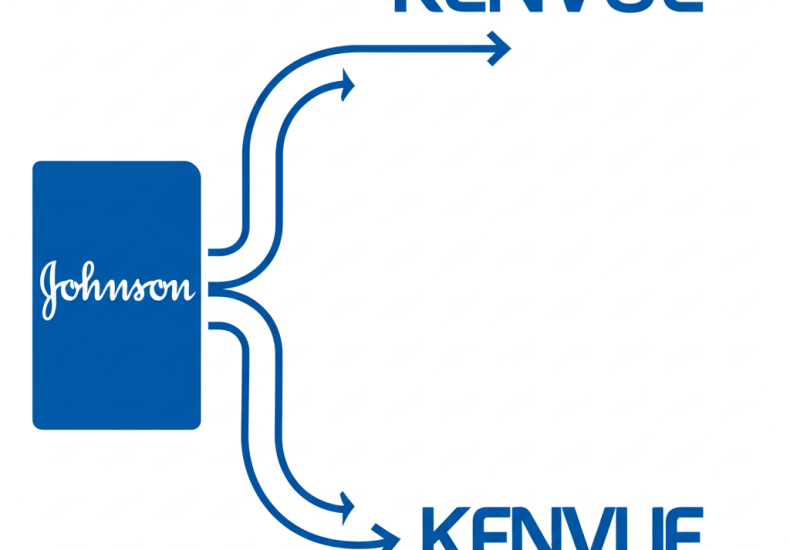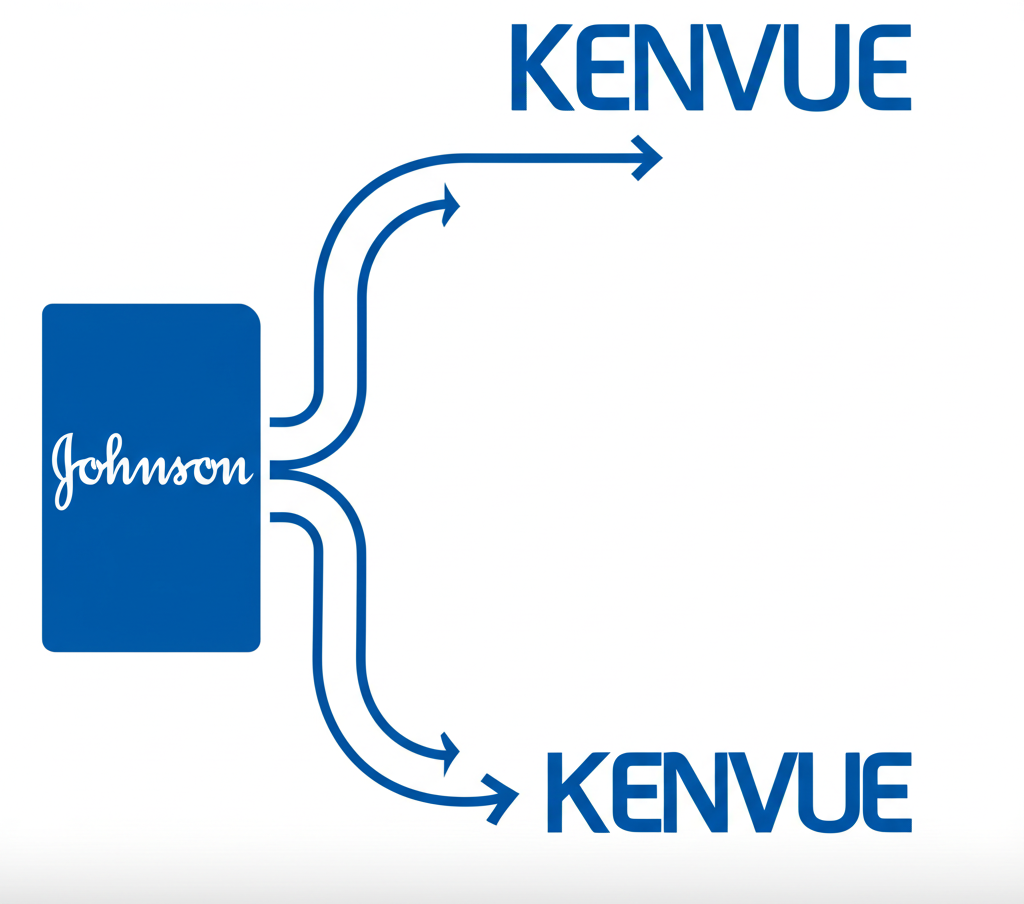
Johnson and Johnson Stock Kenvue: Navigating Your Investment After the Landmark Spinoff
Table of Contents
ToggleIntroduction: Decoding the Johnson & Johnson and Kenvue Spinoff

Johnson & Johnson, a cornerstone of the global healthcare industry for over a century, has undergone one of the most significant corporate transformations in recent memory—the spinoff of its Consumer Health division into a standalone public company named Kenvue Inc. This strategic move marks more than just a structural change; it reflects a deliberate effort to sharpen focus, enhance agility, and unlock long-term value for shareholders. The separation has redefined the investment profiles of both Johnson & Johnson and Kenvue, creating two distinct paths forward in very different corners of the health economy. For investors, this shift brings both complexity and opportunity. Understanding how the spinoff unfolded, how ownership was distributed, and what each company now represents is essential for making informed decisions in today’s evolving market landscape.
The Strategic Impetus Behind the JNJ-Kenvue Separation

At its core, the decision to separate Kenvue from Johnson & Johnson was never about shedding underperformance—it was about strategic clarity. For years, JNJ operated as a sprawling conglomerate with three major business segments: Pharmaceuticals, Medical Devices, and Consumer Health. While each performed well in its own right, the combined structure often led to diluted focus, mismatched growth expectations, and challenges in capital allocation. The leadership recognized that the innovation-driven pace of pharmaceuticals and MedTech demanded a different operational rhythm than the brand-centric, consumer-focused world of over-the-counter health products.
By spinning off Kenvue, JNJ aimed to liberate both organizations. The parent company could redirect its full attention and resources toward high-margin, science-led advancements in medicine and medical technology. Meanwhile, Kenvue would gain the independence to move faster, respond more directly to consumer trends, and build a distinct identity in the competitive consumer health space. This separation wasn’t just a financial engineering exercise—it was a recognition that two focused companies could create more value than one diversified giant.
Johnson & Johnson’s Refocused Growth Strategy

With the Consumer Health segment now independent, Johnson & Johnson has fully transitioned into a pure-play healthcare innovator. Its future hinges on breakthroughs in key therapeutic areas such as oncology, immunology, neuroscience, and cardiovascular disease, supported by a robust pipeline of new drugs and advanced medical technologies. This strategic narrowing allows JNJ to concentrate its R&D investments, accelerate clinical development, and pursue targeted acquisitions that align closely with its core mission.
The company’s leadership has emphasized that the spinoff enables more disciplined capital allocation. Freed from the need to balance the financial profiles of fast-moving consumer goods with long-cycle pharmaceutical development, JNJ can now prioritize projects with the highest scientific and commercial potential. This focus is expected to drive improved operating margins, faster revenue growth in high-value segments, and stronger returns on invested capital. For investors, this shift positions JNJ as a leader in the innovation economy of healthcare, appealing particularly to those seeking exposure to cutting-edge medical science and long-term growth potential. For more details on JNJ’s post-separation strategy, refer to their official investor relations page on the Kenvue separation: Johnson & Johnson Investor Relations – Kenvue Separation.
Kenvue’s Vision as a Standalone Consumer Health Leader
Kenvue enters the market with a bold ambition: to become the world’s leading pure-play consumer health company. Unlike diversified healthcare firms, Kenvue’s entire business model revolves around everyday health and wellness products that consumers use at home. Its portfolio includes some of the most trusted names in the industry—brands that have become synonymous with their categories, such as Tylenol, Band-Aid, Listerine, Neutrogena, and Aveeno.
As an independent entity, Kenvue gains the flexibility to make faster decisions, tailor its marketing strategies to evolving consumer behaviors, and invest selectively in innovation that drives brand relevance. The company is placing a strong emphasis on digital engagement, direct-to-consumer channels, and product enhancements that align with modern wellness trends—such as clean ingredients, sustainability, and personalized care. With a global footprint and deep distribution networks, Kenvue is well-positioned to capitalize on rising health consciousness across both developed and emerging markets. Its leadership believes that autonomy will allow it to operate with greater speed and precision than it could as part of a larger conglomerate.
Understanding the JNJ Exchange Offer and Kenvue Share Distribution
The mechanics of the Kenvue spinoff involved a multi-step process designed to ensure a fair and orderly transition for shareholders. The first major milestone came in May 2023, when Kenvue completed its initial public offering (IPO), pricing shares at $22.00 and beginning trading on the New York Stock Exchange under the ticker “KVUE.” This IPO allowed outside investors to participate early and established a public market valuation for the new company.
The final phase of the separation occurred in August 2023 through a unique exchange offer. Johnson & Johnson invited its shareholders to voluntarily exchange their JNJ shares for Kenvue stock in what functioned similarly to a Dutch auction. The offer was heavily oversubscribed, reflecting strong investor demand for exposure to the consumer health business. Participants received Kenvue shares at a slight discount—approximately $107.50 worth of KVUE stock for every $100 of JNJ stock tendered—providing a tax-efficient mechanism for JNJ to reduce its stake.
For shareholders who chose not to participate in the exchange, Kenvue shares were distributed automatically on a pro-rata basis. This ensured that every eligible JNJ shareholder received a portion of Kenvue, preserving their economic interest in the spun-off business. By the end of the process, Johnson & Johnson’s ownership in Kenvue was reduced from around 90% to just 9.5%, effectively completing the separation while maintaining a strategic minority stake.
Here’s a summary of key dates related to the JNJ-Kenvue spinoff:
| Event | Approximate Date | Significance |
|---|---|---|
| Initial Announcement | November 2021 | JNJ announces intention to separate Consumer Health business. |
| Kenvue IPO Pricing | May 3, 2023 | Kenvue’s shares priced at $22.00 per share for its IPO. |
| Kenvue NYSE Debut | May 4, 2023 | Kenvue common stock begins trading on the NYSE under “KVUE”. |
| Exchange Offer Launch | July 28, 2023 | JNJ launches offer for shareholders to exchange JNJ stock for KVUE. |
| Exchange Offer Expiration | August 18, 2023 | Deadline for JNJ shareholders to tender shares for Kenvue. |
| Final Separation | August 2023 | JNJ completes divestiture, reducing ownership to 9.5%. |
Kenvue Stock Performance and Market Analysis
Since its debut in May 2023, Kenvue’s stock has attracted attention as one of the year’s most notable IPOs. Trading under the symbol KVUE, the stock initially faced volatility common to newly listed companies, influenced by broader market sentiment, consumer spending trends, and investor appetite for consumer staples. Despite these fluctuations, Kenvue has maintained a solid market capitalization, reflecting confidence in its brand strength and long-term stability.
Analyst coverage of KVUE has generally been cautious to optimistic. While few expect hypergrowth, many see Kenvue as a reliable performer with steady cash flow generation, consistent margins, and strong pricing power thanks to its portfolio of household-name brands. Price targets from major financial institutions suggest moderate upside, supported by expectations of disciplined cost management, international expansion, and incremental innovation across its product lines.
The company’s position in the consumer staples sector makes it a potential defensive play during economic downturns, as demand for everyday health products tends to remain resilient even when discretionary spending slows. However, Kenvue is not immune to macroeconomic pressures—rising input costs, supply chain disruptions, and shifts in retail dynamics can all impact profitability. Long-term success will depend on its ability to maintain brand loyalty while adapting to digital-first consumer behaviors and increasing competition from private labels and direct-to-consumer startups.
For a detailed market outlook, major financial news sources often provide analysis, such as this report from Reuters on the spinoff’s completion: Johnson & Johnson spins off consumer health unit Kenvue.
Key Drivers and Challenges for Kenvue’s Stock Value
Kenvue’s stock performance hinges on a combination of brand strength, operational efficiency, and external economic conditions. Internally, the company’s ability to innovate within its existing categories—such as launching new formulations, improving packaging, or expanding into adjacent wellness segments—will be critical to sustaining growth. Marketing effectiveness, particularly in digital channels, plays a growing role in maintaining visibility and relevance among younger consumers.
Financial discipline is another key driver. As a standalone entity, Kenvue must manage its debt load, optimize its supply chain, and deliver consistent earnings to meet investor expectations. The company has signaled its intent to return capital to shareholders through dividends and potential share repurchases, which could support investor sentiment over time.
On the external front, Kenvue faces intense competition. Legacy pharmaceutical firms like GSK and Bayer also have strong consumer health divisions, while retail giants and private-label brands offer lower-cost alternatives. Additionally, digitally native brands are gaining traction by focusing on niche markets, transparency, and sustainability—areas where Kenvue must continue to invest to stay competitive.
Regulatory scrutiny in key markets, especially around product claims and ingredient safety, adds another layer of risk. Any misstep in compliance or public perception could damage brand equity, which is central to Kenvue’s value proposition. Navigating these challenges while maintaining profitability will be a defining test for the new management team.
Kenvue’s Iconic Product Portfolio and Market Position
Few companies in the consumer health space can match Kenvue’s brand portfolio. Its lineup includes some of the most recognizable and trusted names in over-the-counter medicine and personal care. Tylenol remains a leader in pain relief, Band-Aid dominates wound care, and Listerine continues to be a top choice for oral hygiene. In skincare, Neutrogena and Aveeno enjoy strong loyalty, particularly among consumers seeking dermatologist-recommended solutions. Johnson’s Baby, despite evolving parenting trends, still holds a prominent place in infant care routines.
This breadth of brands gives Kenvue a powerful advantage: diversification across multiple high-demand categories. If one segment faces headwinds—such as allergy season variability affecting Zyrtec sales—others can help stabilize overall performance. The company also benefits from economies of scale in manufacturing, distribution, and advertising, allowing it to maintain wide retail presence across pharmacies, supermarkets, and e-commerce platforms.
Moreover, many of these brands have decades of consumer trust behind them. In an era where authenticity and reliability matter more than ever, that legacy provides a durable competitive moat. Kenvue is leveraging this trust to expand into adjacent areas, such as men’s grooming, feminine care, and mental wellness, often through product line extensions or targeted acquisitions.
Kenvue’s Competitive Strategy and Innovation Post-Separation
As an independent company, Kenvue is no longer bound by the strategic priorities of a diversified healthcare giant. This autonomy allows it to pursue a more agile and consumer-centric approach. One of its key strategic pillars is digital transformation—investing in data analytics, e-commerce capabilities, and direct-to-consumer platforms to deepen engagement and gather real-time insights into consumer behavior.
Product innovation remains central. Kenvue is focusing on reformulations that align with modern preferences—such as fragrance-free, hypoallergenic, or environmentally friendly options—while also exploring new delivery methods and personalized health solutions. For example, the company has been active in developing app-integrated skincare regimens and digital symptom checkers that guide consumers to the right products.
Internationally, Kenvue sees significant growth potential in emerging markets, where rising incomes and greater health awareness are driving demand for branded over-the-counter products. The company is expanding distribution in regions like Southeast Asia, Latin America, and parts of Africa, often through partnerships with local retailers and healthcare providers.
Despite these strengths, Kenvue must contend with a fragmented and fast-moving landscape. To maintain its leadership, it will need to balance cost efficiency with brand investment, respond quickly to market shifts, and continue building relevance among digitally savvy consumers. You can explore their brand portfolio and strategy on the Kenvue Investor Relations website: Kenvue Investor Relations – About Kenvue.
Investment Considerations for Both JNJ and Kenvue Stock
The spinoff has created two fundamentally different investment opportunities. Johnson & Johnson, now focused exclusively on Pharmaceuticals and MedTech, appeals to investors seeking exposure to high-growth, science-driven innovation. The company’s success will depend on its ability to bring new drugs and medical devices to market, defend against generic competition, and navigate complex regulatory environments. While this path offers higher growth potential, it also comes with greater risk—clinical trial failures or patent expirations can significantly impact performance.
Kenvue, by contrast, fits the profile of a classic consumer staples play. Its revenue stream is more predictable, driven by everyday purchases that are less sensitive to economic cycles. This makes KVUE attractive to income-oriented and defensive investors. The company’s strong brand portfolio supports pricing power and consistent margins, though growth may be more modest compared to JNJ’s innovation pipeline.
To help differentiate, consider the following comparative overview:
| Feature | Johnson & Johnson (JNJ) | Kenvue (KVUE) |
|---|---|---|
| Primary Business Focus | Pharmaceuticals & Medical Technology | Consumer Health Products |
| Market Sector | Healthcare (Pharmaceuticals, Biotech, MedTech) | Consumer Staples |
| Growth Drivers | Innovation, R&D pipeline, M&A in specialized areas | Brand strength, market share, product extensions, emerging markets |
| Risk Profile | Regulatory hurdles, clinical trial failures, patent expirations | Consumer spending shifts, competitive pressure, raw material costs |
| Dividend Characteristics | Long history of consistent dividend growth (“Dividend King”) | New dividend policy, expected to be a solid income payer |
Dividend Policies: JNJ vs. Kenvue After the Spinoff
For income-focused investors, the dividend outlook for both companies is a key consideration. Johnson & Johnson has earned its reputation as a “Dividend King,” having increased its payout for over 60 consecutive years. While the spinoff reduced its earnings base, the company has reaffirmed its commitment to maintaining a strong dividend, though future growth rates may moderate as it reinvests in high-potential medical innovations.
Kenvue, as a new independent entity, has established its own dividend framework. The company initiated a quarterly dividend shortly after the separation, signaling its intent to return value to shareholders. Given its stable cash flows and position in consumer staples, KVUE is expected to become a reliable income generator. However, investors should monitor payout ratios and earnings trends to assess the sustainability of its dividend over time.
The combination of JNJ and KVUE dividends may differ from the pre-spinoff dividend income, so investors should evaluate how the new structure aligns with their income goals.
Understanding Tax Implications for Kenvue Stock Recipients
For U.S. shareholders, the distribution of Kenvue stock was generally treated as a tax-free event for federal income tax purposes. This means no immediate tax liability was triggered when shareholders received KVUE shares through the exchange offer or pro-rata distribution. However, this does not eliminate all tax considerations.
The original cost basis of your Johnson & Johnson shares must be allocated between the remaining JNJ stock and the newly received Kenvue shares. The allocation is typically based on the relative market values of the two stocks immediately after the separation. For example, if JNJ and KVUE were valued at 70% and 30% of the combined total, then 70% of your original cost basis would apply to JNJ and 30% to KVUE.
Accurately determining this split is crucial, as it will affect the capital gains or losses you report when you eventually sell either stock. While brokerage firms often provide cost basis guidance, it’s wise to verify the calculation. Given the complexity and potential variability based on individual holdings, investors are strongly encouraged to consult a qualified tax advisor to ensure compliance and accurate reporting.
Conclusion: The Independent Futures of Johnson & Johnson and Kenvue
The separation of Johnson & Johnson and Kenvue represents a pivotal moment in corporate strategy—a deliberate move to unlock value by aligning structure with purpose. JNJ now stands as a more focused, innovation-driven healthcare leader, poised to push the boundaries of medicine and medical technology. Kenvue emerges as a powerful, agile consumer health company, built on a foundation of trusted brands and everyday relevance.
For investors, this split offers a rare opportunity to choose between two distinct paths: one rooted in scientific advancement and high-growth potential, the other in brand stability and consistent cash flow. While the mechanics of the separation are complete, the real story lies ahead—how each company executes its strategy, adapts to market changes, and delivers long-term value. By understanding their unique strengths, risks, and growth trajectories, investors can make more informed decisions in the evolving healthcare and consumer landscapes.
Frequently Asked Questions (FAQ)
1. What is Kenvue, and how is its relationship with Johnson & Johnson defined post-separation?
Kenvue is the independent company formed from Johnson & Johnson’s former Consumer Health division. Post-separation, Kenvue operates entirely autonomously, managing its own iconic brands like Tylenol, Band-Aid, and Neutrogena. Johnson & Johnson retains a minority stake (approximately 9.5%) but no longer controls Kenvue’s operations or strategic direction.
2. Did Johnson & Johnson shareholders automatically receive shares of Kenvue stock, or was action required?
Johnson & Johnson shareholders had two primary ways to receive Kenvue shares: through a voluntary exchange offer (Dutch auction) or, for those who did not participate in the exchange, through an automatic pro-rata distribution of Kenvue shares. Therefore, all eligible JNJ shareholders ultimately received Kenvue shares, though the mechanism varied.
3. Can you explain the mechanics and final outcome of the JNJ exchange offer for Kenvue shares?
The JNJ exchange offer allowed shareholders to exchange their JNJ common stock for Kenvue common stock at a discount, providing a tax-efficient way for JNJ to divest its majority stake. The offer concluded in August 2023, with JNJ successfully reducing its ownership in Kenvue to 9.5%, completing the full separation.
4. What are the general tax implications for U.S. shareholders who received Kenvue stock as a result of the spinoff?
For U.S. federal income tax purposes, the distribution of Kenvue stock was generally intended to be tax-free. However, shareholders need to allocate their original cost basis of JNJ shares between their remaining JNJ stock and the newly received Kenvue stock. It is critical to consult a qualified tax professional for personalized advice, as individual circumstances affect tax outcomes.
5. What is the current stock performance of Kenvue, and what are the future price targets and forecasts?
Kenvue stock (KVUE) debuted on the NYSE in May 2023. Its performance has since tracked broader market trends and investor sentiment towards the consumer staples sector. Analyst price targets and forecasts vary but generally reflect expectations for stable growth, given its strong brand portfolio and market position. Investors should refer to current financial news and analyst reports for up-to-date performance and outlook.
6. Which well-known products and brands are now part of Kenvue’s independent portfolio?
Kenvue’s portfolio includes many globally recognized consumer health brands such as:
- Tylenol (pain relief)
- Band-Aid (wound care)
- Listerine (oral hygiene)
- Neutrogena (skin and beauty)
- Johnson’s Baby (baby care)
- Aveeno (skincare)
- Zyrtec (allergy relief)
These brands cover various categories from over-the-counter medications to personal care.
7. How has the Kenvue spinoff altered Johnson & Johnson’s core business strategy and investment focus?
The Kenvue spinoff has allowed Johnson & Johnson to sharpen its focus exclusively on its high-growth Pharmaceutical and Medical Technology (MedTech) segments. This strategic shift is intended to streamline R&D, accelerate innovation, and optimize capital allocation towards breakthrough therapies and advanced medical devices, aiming for higher margins and faster growth.
8. What are the current dividend policies for both Johnson & Johnson and Kenvue following the separation?
Johnson & Johnson remains committed to its long-standing dividend policy as a “Dividend King,” though its payout ratio may adjust with the refocused business. Kenvue has established its own dividend policy as an independent company, initiating quarterly dividends, which makes it an attractive option for income-focused investors in the consumer staples sector.
9. Where can investors find official and reliable news or financial updates regarding Johnson & Johnson and Kenvue?
Investors should primarily refer to the official investor relations websites for each company:
- For Johnson & Johnson: investor.jnj.com
- For Kenvue: kenvue.com/investors
Additionally, reputable financial news outlets (e.g., Wall Street Journal, Bloomberg, Reuters) provide reliable coverage and analysis.
10. Considering the recent spinoff, is Kenvue stock currently considered a good investment, and what are its long-term growth prospects?
Whether Kenvue stock is a “good investment” depends on an individual investor’s financial goals and risk tolerance. As a pure-play consumer health company, Kenvue offers stability and predictable cash flows, appealing to income and defensive investors. Its long-term growth prospects are tied to sustained brand strength, innovation in consumer health, and expansion into growing markets. It’s crucial to conduct thorough due diligence and consider consulting a financial advisor.
You may also like
Calendar
| 一 | 二 | 三 | 四 | 五 | 六 | 日 |
|---|---|---|---|---|---|---|
| 1 | 2 | 3 | 4 | 5 | 6 | 7 |
| 8 | 9 | 10 | 11 | 12 | 13 | 14 |
| 15 | 16 | 17 | 18 | 19 | 20 | 21 |
| 22 | 23 | 24 | 25 | 26 | 27 | 28 |
| 29 | 30 | 31 | ||||
發佈留言
很抱歉,必須登入網站才能發佈留言。